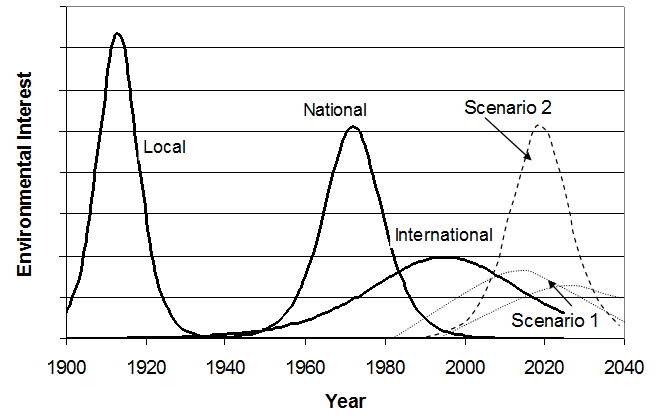In the 20th century, three key environmental issues arose at different times and different political scopes: (1) the sanitary phase of rapidly growing urban centers in the early 20th century; (2) national concern with clean air and water with action peaking in the early 1970’s; and (3) international concern over trans-boundary issues (e.g., wildlife) and atmospheric release (e.g., chlorofluorocarbons, sulfur dioxide, and carbon dioxide) with treaties peaking in the mid 1990’s. (see figure below). These phases of environmental activities seem to indicate a pattern of periodic interest as technologies are developed, environmental problems arise, and social responses are formulated. However, throughout the 20th century the time between these phases decreased while the time to resolve each phase increased. Continuing this pattern would be unsustainable as the environmental problems would continue to pile up without satisfactory resolution (Scenario 1 in the figure below).

This leads to questions concerning ways of understanding waves, their connections, and their directions. Specifically, what is the next environmental phase and how will it’s resolution be organized? A prediction based on an “S”-curve learning trend is that new issues, such as global climate change, trade, inequality, and environmental degradation, need to be addressed at a quicker pace as the world population and energy demand increases. This would lead to the next environmental phase peaking in just over another decade (Scenario 2 in the figure).
What might be next? There are many dimensions to be considered, including new technologies, better understanding, new governance models, and new levels of environmental complexity. For example, new technologies, include combinations of genomics, robotics, artificial intelligence, and nanotechnology, which offer both potential environmental benefits and risks. Better understanding can be gained by making measurements, constructing models, and viewing the issues as part of a larger ecological and economic system. Better governance models might include longer-term robust strategies that include considerations of uncertainties but are periodically reviewed as new information becomes available. New levels of environmental complexity can be identified as limits of energy and food production are approached and integrated into a sustainable system.
A critical factor for determining which scenario is realized is the relative rate of technology development compared to the social response. Possible leading indicators of the next period of environmental interest include new social mechanisms such as the incorporation of environmental impacts in economic accounting and the responsible development of new technologies.





Comments